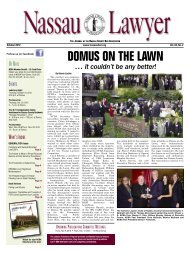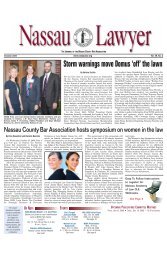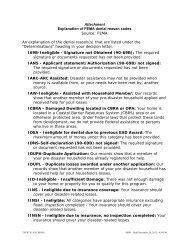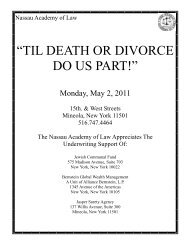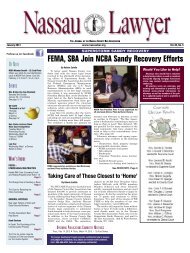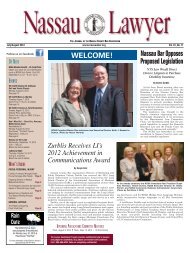397 B.R. 642 Page 13397 B.R. 642(Cite as: 397 B.R. 642)fendant had separate property claims for the loan. Thisratification occurred more than ninety (90) days beforeDebtor filed for bankruptcy protection. As such, theDebtor did receive value for the release <strong>of</strong> his obligationsfor the loan. Had the loan not been released, the parentsmight have asserted an equitable lien against the MaritalResidence.Based upon the foregoing analysis, this Court holds thatthe Transfer was not a fraudulent transfer, and therefore,the Trustee's Claim under Section 548 must fail. Accordingly,for the reasons stated above, the Court finds thatthat portion <strong>of</strong> the Debtor's motion seeking summaryjudgment on Count 1 <strong>of</strong> the Amended Complaint shouldbe granted, and that portion <strong>of</strong> the Trustee's Cross-Motionon Count 1 <strong>of</strong> the Amended Complaint should be denied.The Transfer Was Not a Constructive Intent FraudulentConveyanceIn Count 2 <strong>of</strong> the Amended Complaint, the Trustee allegesthat the Transfer can *657 be avoided under DCL §273 as a constructively fraudulent conveyance. An essentialelement to proving a constructively fraudulent conveyanceis that the transfer lacks fair consideration. Asnoted above, DCL § 272 defines fair consideration. ThisCourt adopts the above analysis <strong>of</strong> the exchange <strong>of</strong> considerationas it relates to Count 1 <strong>of</strong> the Amended Complaint,and hereby incorporates by reference that analysiswith respect to Count 2 <strong>of</strong> the Complaint. As a result,Debtor received fair consideration as a matter <strong>of</strong> law.Therefore, that portion <strong>of</strong> Defendant's motion seekingsummary judgment as to Count 2 <strong>of</strong> the Amended Complaintshould be granted, and that portion <strong>of</strong> the Trustee'sCross-Motion as to Count 2 <strong>of</strong> the Amended Complaintshould be denied.The Transfer Was Not a Conveyance by a Person Aboutto Incur DebtsThe Trustee in Count 3 <strong>of</strong> the Amended Complaint seeksto avoid the Transfer under DCL § 275 as a conveyancemade by a person about to incur debts. As with DCL §273, an essential element to the DCL § 275 claim is thatthe transfer was made or incurred without fair consideration.The Court adopts its analysis and conclusion above,that Debtor received fair consideration as a matter <strong>of</strong> law.Therefore, that portion <strong>of</strong> Defendant's motion seekingsummary judgment as to Count 3 <strong>of</strong> the Amended Complaintshould be granted, and that portion <strong>of</strong> the Trustee'sCross-Motion as to Count 3 <strong>of</strong> the Amended Complaintshould be denied.The Transfer Was Not a PreferenceCount 5 <strong>of</strong> the Amended Complaint seeks to avoid theTransfer as a preference under Section 547. First, as to theparents <strong>of</strong> the Defendant, repayment <strong>of</strong> their loan was notan insider preference. In addition, Defendant did not receivea preference.[13][14] The Trustee bears the burden <strong>of</strong> pro<strong>of</strong> on allelements <strong>of</strong> a preference claim under Section 547. Includedwithin those elements are insolvency <strong>of</strong> the debtorat the time <strong>of</strong> the Transfer, under Section 547(b)(3), andthat the transferee received more than it would have receivedunder Chapter 7 had the transfer at issue not beenmade, under Section 547(b)(5). The Trustee has failed toraise a genuine issue <strong>of</strong> material fact on either <strong>of</strong> theseelements.Section 547(f) creates a presumption that the Debtor wasinsolvent, but that presumption applies only to the ninety(90) days preceding the petition date. Here, the Transferoccurred ninety-four (94) days preceding the petition dateif measured from the Decree <strong>of</strong> Divorce, or one hundredand twenty-five (125) days prior to the petition date ifmeasured from the date <strong>of</strong> the Transfer itself. As such,there is no presumption <strong>of</strong> insolvency.The only evidence <strong>of</strong> solvency <strong>of</strong> the Debtor before thisCourt is Debtor's retention <strong>of</strong> his $92,000 annuity andDebtor's retention <strong>of</strong> certain personal property. As Debtorclearly had equity in the Marital Residence, and was relieved<strong>of</strong> all other marital liabilities, the Court cannotconclude that a genuine issue exists as to Debtor's insolvencyat the time <strong>of</strong> Transfer.Moreover, the Trustee did not provide evidence <strong>of</strong> insolvency.He simply stated in his Affirmation that "Debtorwas insolvent at the time the parties entered into the SettlementAgreement." [dkt item 17, Ex. 2, 3] This unsupportedconclusion is not adequate under Anderson andMatsushita to raise a genuine issue <strong>of</strong> material fact. SeeAnderson, 477 U.S. at 249, 106 S.Ct. 2505, andMatsushita, 475 U.S. at 586, 106 S.Ct. 1348. Moreover,the Trustee's assertion does not address November 11,2003, when the Transfer occurred, or December 10, 2003,when the Judgment <strong>of</strong> Divorce was entered. As such, theTrustee *658 did not raise a genuine issue <strong>of</strong> material facton Debtor's insolvency.Therefore, that portion <strong>of</strong> Defendant's Motion seekingsummary judgment as to Count 5 <strong>of</strong> the Amended Complaintshould be granted, and that portion <strong>of</strong> the Trustee's© 2009 Thomson Reuters. No Claim to Orig. US Gov. Works.
397 B.R. 642 Page 14397 B.R. 642(Cite as: 397 B.R. 642)Cross-Motion as to Count 5 <strong>of</strong> the Amended Complaintshould be denied.This Court Does Not Reach the Issue <strong>of</strong> Application <strong>of</strong>BFP to a Preference ClaimIn light <strong>of</strong> this Court's disposition <strong>of</strong> the Trustee's preferenceclaim, this Court need not and therefore does notreach the issue <strong>of</strong> the application <strong>of</strong> BFP v. ResolutionTrust Corp. to a preference claim under Bankruptcy Code§ 547.The "Repayment" <strong>of</strong> the Parents' Loan was Not a PreferenceThe Trustee argues that, even if the money provided tothe Debtor and Defendant by Defendant's parents is considereda loan, the "repayment" <strong>of</strong> the $61,000 Debtorallegedly owed the parents should still be set aside as animpermissible preference to an insider pursuant to Section547. As noted above, the repayment <strong>of</strong> the parents' loanoccurred more than ninety days prior to the Petition Date.As there is no genuine issue <strong>of</strong> material fact as to Debtor'ssolvency during that period, Defendant's parents did notreceive an insider preference.This Court Rejects Defendant's Affirmative Defenses tothe Preference ClaimThis Court rejects Defendant's affirmative defenses to theTrustee's preference claim. Defendant asserts that the repayment<strong>of</strong> the parents loan was not a preference based onthe defense <strong>of</strong> "contemporaneous exchange" underBankruptcy Code Section 547(c)(1), and as a support obligationunder Section 547(c)(7). Defendant asserts asfollows:The defendant in return for obtaining the debtor's halfinterest in the marital residence, gave up a basket <strong>of</strong>items as outlined in her Affidavit. This is clearly the"contemporaneous exchange" referred to in BankruptcyCode § 547(c)(1), as a defense to a preferential transferclaim. In fact, the Judgment <strong>of</strong> Divorce treats the maritalresidence transfer and the settlement agreement as"contemporaneous." (Exhibit C, page 7, paragraph b)16. As a further defense to this preferential claim underBankruptcy Code § 547, the defendant in her answer tothe amended complaint refers to Bankruptcy Code §547(c)(7) which provides that a bona fide payment <strong>of</strong> adebt to a spouse, former spouse or child <strong>of</strong> the debtorfor alimony, maintenance or support for such spouse orchild in connection with a separation agreement, divorcedecree or other order <strong>of</strong> a court <strong>of</strong> record made inaccordance with a state law or property settlementagreement is a defense to a preferential transfer claim.Clearly § 547(c)(7) was intended to protect spouses orformer spouses against the preferential payment claimsby trustees.[dkt items 15].[15] Defendant's affirmative defense <strong>of</strong> contemporaneousexchange under Section 547(c)(1) is rejected. The obligationsto Defendant's parents that arose prior to or evenduring the course <strong>of</strong> the divorce proceedings were notcontemporaneous exchanges with the Transfer, nor werethose exchanges intended to be contemporaneous. Thoseobligations preceded the Transfer and were released as aresult <strong>of</strong> the Transfer.[16] Moreover, the parents' loan does not qualify for theaffirmative defense under Section 547(c)(7). As Section547(c)(7) stood prior to the enactment <strong>of</strong> BAPCPA, thisdefense was for payments made on a *659 bona fide debtto the extent made for alimony, maintenance or support <strong>of</strong>the spouse or former spouse <strong>of</strong> the debtor or a child <strong>of</strong> thedebtor. Here, the parents' loan does not qualify for thisdefense.ConclusionSummary judgment will be granted in favor <strong>of</strong> Defendantand denied as to the Trustee on Counts 1, 2, 3, and 5 <strong>of</strong>the Trustee's Amended Complaint. Summary judgment isdenied as to both parties on Counts 4, 6, 7, and 8. A trialdate will be scheduled by the Court on these remainingclaims. A separate judgment hereon will be entered.397 B.R. 642END OF DOCUMENT© 2009 Thomson Reuters. No Claim to Orig. US Gov. Works.
- Page 1 and 2:
Nassau Academy of LawCLE Live Class
- Page 3 and 4:
McKinney's Debtor and Creditor Law
- Page 5 and 6:
McKinney's Debtor and Creditor Law
- Page 7 and 8:
McKinney's Debtor and Creditor Law
- Page 9 and 10:
McKinney's Debtor and Creditor Law
- Page 11 and 12:
McKinney's Debtor and Creditor Law
- Page 13 and 14:
McKinney's Debtor and Creditor Law
- Page 15 and 16:
McKinney's Debtor and Creditor Law
- Page 17 and 18:
McKinney's Debtor and Creditor Law
- Page 19 and 20:
BAKER & HOSTETLER LLP45 Rockefeller
- Page 21 and 22:
usiness of defendant Bernard L. Mad
- Page 23 and 24:
BACKGROUND, THE TRUSTEE, AND STANDI
- Page 25 and 26:
Madoff who received fraudulent tran
- Page 27 and 28:
ased on fictitious profits and for
- Page 29 and 30:
28. BLMIS funds were also used to p
- Page 31 and 32:
Madoff, and her niece, Shana Madoff
- Page 33 and 34:
42. Ruth Madoff was never an employ
- Page 35 and 36:
FIRST CAUSE OF ACTIONTURNOVER AND A
- Page 37 and 38:
66. At the time of each of the Two-
- Page 39 and 40:
Transfers; (b) directing that the S
- Page 41 and 42:
EIGHTH CAUSE OF ACTIONUNDISCOVERED
- Page 43 and 44:
TENTH CAUSE OF ACTIONDISALLOWANCE O
- Page 45 and 46:
111. Mrs. Madoff benefited from the
- Page 47 and 48:
WHEREFORE, the Trustee respectfully
- Page 49 and 50:
2(c)(3): (a) preserving the Subsequ
- Page 51 and 52:
302 B.R. 760 Page 1302 B.R. 760(Cit
- Page 53 and 54: 302 B.R. 760 Page 3302 B.R. 760(Cit
- Page 55 and 56: 302 B.R. 760 Page 5302 B.R. 760(Cit
- Page 57 and 58: 302 B.R. 760 Page 7302 B.R. 760(Cit
- Page 59 and 60: 302 B.R. 760 Page 9302 B.R. 760(Cit
- Page 61 and 62: 302 B.R. 760 Page 11302 B.R. 760(Ci
- Page 63 and 64: 302 B.R. 760 Page 13302 B.R. 760(Ci
- Page 65 and 66: 302 B.R. 760 Page 15302 B.R. 760(Ci
- Page 67 and 68: 302 B.R. 760 Page 17302 B.R. 760(Ci
- Page 69 and 70: 302 B.R. 760 Page 19302 B.R. 760(Ci
- Page 71 and 72: 394 B.R. 721 Page 1394 B.R. 721, 50
- Page 73 and 74: 394 B.R. 721 Page 3394 B.R. 721, 50
- Page 75 and 76: 394 B.R. 721 Page 5394 B.R. 721, 50
- Page 77 and 78: 394 B.R. 721 Page 7394 B.R. 721, 50
- Page 79 and 80: 394 B.R. 721 Page 9394 B.R. 721, 50
- Page 81 and 82: 394 B.R. 721 Page 11394 B.R. 721, 5
- Page 83 and 84: 394 B.R. 721 Page 13394 B.R. 721, 5
- Page 85 and 86: 394 B.R. 721 Page 15394 B.R. 721, 5
- Page 87 and 88: 394 B.R. 721 Page 17394 B.R. 721, 5
- Page 89 and 90: 394 B.R. 721 Page 19394 B.R. 721, 5
- Page 91 and 92: 394 B.R. 721 Page 21394 B.R. 721, 5
- Page 93 and 94: 397 B.R. 642 Page 2397 B.R. 642(Cit
- Page 95 and 96: 397 B.R. 642 Page 4397 B.R. 642(Cit
- Page 97 and 98: 397 B.R. 642 Page 6397 B.R. 642(Cit
- Page 99 and 100: 397 B.R. 642 Page 8397 B.R. 642(Cit
- Page 101 and 102: 397 B.R. 642 Page 10397 B.R. 642(Ci
- Page 103: 397 B.R. 642 Page 12397 B.R. 642(Ci
- Page 107 and 108: 443 F.3d 180 Page 2443 F.3d 180(Cit
- Page 109 and 110: 443 F.3d 180 Page 4443 F.3d 180(Cit
- Page 111 and 112: 443 F.3d 180 Page 6443 F.3d 180(Cit
- Page 113 and 114: 443 F.3d 180 Page 8443 F.3d 180(Cit
- Page 115 and 116: 443 F.3d 180 Page 10443 F.3d 180(Ci
- Page 117 and 118: 443 F.3d 180 Page 12443 F.3d 180(Ci
- Page 119 and 120: Page 2257 A.D.2d 526, 684 N.Y.S.2d
- Page 121 and 122: Page 4257 A.D.2d 526, 684 N.Y.S.2d
- Page 123 and 124: Page 6257 A.D.2d 526, 684 N.Y.S.2d
- Page 125 and 126: 770 N.Y.S.2d 421 Page 22 A.D.3d 780
- Page 127 and 128: Page 14 A.D.3d 495, 773 N.Y.S.2d 71
- Page 129: Page 34 A.D.3d 495, 773 N.Y.S.2d 71
- Page 132 and 133: 780 N.Y.S.2d 409 Page 29 A.D.3d 553
- Page 134 and 135: Page 134 A.D.3d 231, 824 N.Y.S.2d 3
- Page 136 and 137: Page 334 A.D.3d 231, 824 N.Y.S.2d 3
- Page 138 and 139: Page 2991 F.2d 31(Cite as: 991 F.2d
- Page 140 and 141: Page 4991 F.2d 31(Cite as: 991 F.2d
- Page 142 and 143: Page 6991 F.2d 31(Cite as: 991 F.2d
- Page 144 and 145: FRAUDULENT TRANFERENCESRonald M. Te
- Page 146 and 147: Nursing home case_ Transfer of pers
- Page 148 and 149: Sections 548 and 544 work in concer
- Page 150 and 151: U.S. Supreme CourtBFP v. Resolution
- Page 152 and 153: example, from net 15 to COD; or cha
- Page 154 and 155:
Bankruptcy Code Section§ 548. Frau
- Page 156:
Ron Terenzi is a founding partner a



